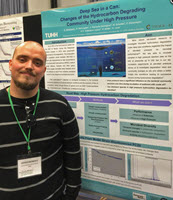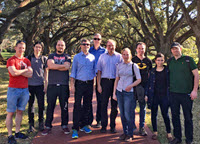
The Deepwater Horizon incident occurred at 1500 m depth, where the pressure is approximately 15 MPa, but little is known about how such high pressure affects the metabolic processes involved with oil biodegradation for bacteria that live there. Steffen Hackbusch conducts laboratory experiments that incubate microbes collected from deep-sea Gulf of Mexico sediment in seawater treated with oil and dispersant in high-pressure reactors mimicking deep-sea conditions. His observations of how the microbes react under high-pressure conditions will help inform future oil spill response as decision makers consider biodegradation at depth as they develop remediation strategies.
Steffen is a microbiology Ph.D. student at the Hamburg University of Technology’s Institute of Technical Biocatalysis and a GoMRI Scholar with the Center for the Integrated Modeling and Analysis of Gulf Ecosystems II (C-IMAGE II).
His Path
Steffen’s interest in science started with having two brothers, “As physical fights became an outdated way to prove who was right, we started using logical arguments and reasoning – and still do over the holidays!” As a high school student, he was fascinated by history and physics and wondered if he could become well-educated simply by reading enough. When he realized that science often identifies as many questions as it does answers, he was hooked.

Steffen initially studied engineering as an undergraduate at the University of Duisburg-Essen hoping to answer questions about how things work. He later changed his degree to water science (a degree path involving biochemistry with a focus on water) after his father, a physics teacher, inspired questions about why things work. While working towards a master’s degree in evolution, ecology, and systematics at Friedrich Schiller University Jena, Steffen attended lectures by Dr. Kirsten Küsel and Dr. Hans-Curt Flemming that sparked his interest in microbial evolution. Following his master’s research, Steffen began his Ph.D. studies at Hamburg University of Technology with Dr. Rudolf Müller and Dr. Andreas Liese, who were searching for a microbiologist to help their team investigate the dynamics of oil fate under deep-sea conditions.
“I enjoy contributing to the scientific process of accumulating knowledge that helps protect the world humans live in, especially the deep sea which is a huge part of our ecosystem that we know little about,” said Steffen.
His Work

Steffen puts oil-degrading microbes that were collected near the Deepwater Horizon site into high-pressure reactors that simulate deep-sea conditions to observe how they are affected by different pressures. His trials expose microbes to 10 and 15 MPa pressure with 1% v/v of oil (a concentration that caused degradation/growth effects in previous experiments) and dispersant concentrations similar to what was applied at depth during the spill.
Steffen incubates a single oil-degrading species in a reactor tube to see how it deals with pressure alone and then with combinations of pressure and the presence of oil and dispersant. He measures growth and estimates the number of viable bacteria cells after exposure. He repeats the experiment using entire microbial communities collected from upper layers of seafloor sediment near the spill site. Using next-generation sequencing on microbes after exposure treatments, Steffen identifies relative increases and decreases in microbial abundance under different conditions.
Steffen explained that by assessing single species and whole communities, researchers can acquire two perspectives about exposure: an ecological view of how an ecosystem may react and a close-up view of the molecular processes involved with a single species. So far, he observed various microbial responses, with some species experiencing difficulty growing and consuming oil at elevated pressure while others appeared unaffected. Though his exposure trials are still on-going, early results suggest that dispersant may have greater impacts on microbial community structure compared to oil and pressure.
“We hope to contribute to the overall picture dealing with future oil spills by stressing that pressure has to be considered in the microbial degradation of crude oil,” said Steffen. “There are several studies from fellow GoMRI members addressing pressure as a factor that influences bacterial communities, and our research is able to contribute to that discussion.”
His Learning
Working in Dr. Liese’s lab, Steffen learned the importance of team work and was able to view and approach his research from new angles through conversations with his colleagues, particularly fellow graduate student Nuttapol Noirungsee. Collaborating with other researchers and learning about their findings at the annual Gulf of Mexico Oil Spill and Ecosystem Science Conference was a particularly striking experience for Steffen. “Seeing so many bright minds working towards one goal had a lasting impression on me,” he said. “I particularly enjoyed working in an international consortium, where you can meet people from around the world sharing ideas and passions.”
His Future
After defending his thesis, Steffen hopes to continue his journey answering scientific questions and pursuing new challenges and opportunities.
Praise for Steffen
Dr. Liese describes Steffen as a highly motivated scientist with a burning desire to help elucidate the effects of pressure and Corexit dispersant on deep-sea microbes. “Steffen is very eager to teach himself and learn new methods that support his research,” said Dr. Liese. “I am very happy that he is a member of our interdisciplinary team as a microbiologist.”
The GoMRI community embraces bright and dedicated students like Steffen Hackbusch and their important contributions. The GoMRI Scholars Program recognizes graduate students whose work focuses on GoMRI-funded projects and builds community for the next generation of ocean science professionals. Visit the C-IMAGE website to learn more about their work.
By Stephanie Ellis and Nilde Maggie Dannreuther. Contact sellis@ngi.msstate.edu for questions or comments.
************
The Gulf of Mexico Research Initiative (GoMRI) is a 10-year independent research program established to study the effect, and the potential associated impact, of hydrocarbon releases on the environment and public health, as well as to develop improved spill mitigation, oil detection, characterization and remediation technologies. An independent and academic 20-member Research Board makes the funding and research direction decisions to ensure the intellectual quality, effectiveness and academic independence of the GoMRI research. All research data, findings and publications will be made publicly available. The program was established through a $500 million financial commitment from BP. For more information, visit https://gulfresearchinitiative.org/.
© Copyright 2010-2019 Gulf of Mexico Research Initiative (GoMRI) – All Rights Reserved. Redistribution is encouraged with acknowledgement to the Gulf of Mexico Research Initiative (GoMRI). Please credit images and/or videos as done in each article. Questions? Contact web-content editor Nilde “Maggie” Dannreuther, Northern Gulf Institute, Mississippi State University (maggied@ngi.msstate.edu).
